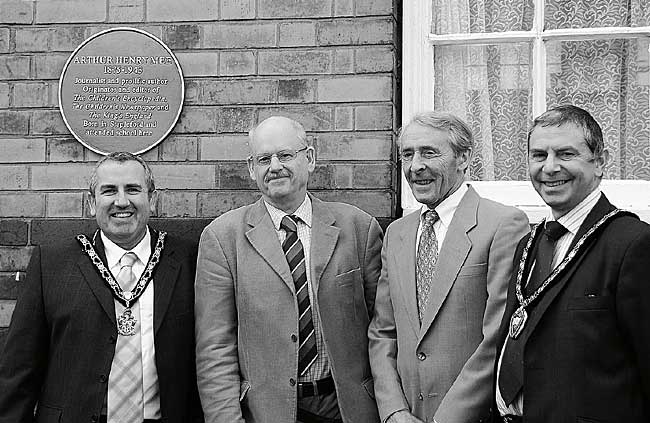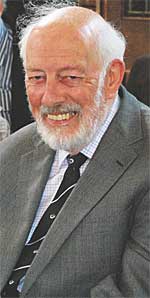News for Summer 2011
Thoroton Society Research Group
In their responses to the Society’s membership questionnaire last year, a considerable number of members expressed interest in taking part in a research project. A Research Group has now been set up and the first meeting was held in the Thoroton Room at Bromley House on Saturday, 26 March 2011. Although attended by only a small number, the meeting was very positive. Members described their interests and a number of suggestions were made, including the setting up of a database of members’ interests, assisting members with getting their research published and the concept of mentoring for those members new to research. One objective of the database is to enable members to see what studies are currently being carried out and to make contact with other members of the Society with similar interests. Collaborative research projects discussed included the Millennium project to photograph every listed building, the Victoria County History project and the Southwell and Nottingham Diocese Church History project. With the approach of the centenary of the Great War, it may be possible to obtain small grants for groups studying the effects of the war on people at home.
Several members in response to the questionnaire, wished to have more Society lectures in addition to the current six. One suggestion was to have an additional Lecture meeting at which members of the Society could have 10-15 minutes to give a short talk on an aspect of their research.
The research database so far includes:
- various aspects of village history
- history of the parish of Bramcote (part of the Victoria County History project)
- early coal mining and related road, rail and water transport in Wollaton and surrounding areas
- war memorials, particularly from the Great War
- the history of Bromley House, including its garden
- Robert Taylor, the architect of Bromley House
- slate headstones
- origins of the ‘Belvoir Angels’ carvings
- church clocks made by Richard Row of Epperstone
- weather and human affairs
- aspects of disease and public health in the 19th and early 20th centuries
- history of J. A. Coombs and Co. Ltd., flour millers and purveyors of ‘health products’
If other members of the Society wish to join the Research Group and to have their interests included in the research database, please contact John Wilson at wilsonicus@hotmail.co.uk.
It is planned to hold another group meeting later in the year to review progress.
John Wilson
A plaque for Arthur Mee at Stapleford

Pat Laly (Mayor of Broxtowe), Francis Luckcock, Alan Mee, Kevin Thomas (Mayor of Stapleford).
I am sure many of you remember owning, as a child, a prized set of volumes of The Children’s Encyclopedia, or remember reading The Children’s Newspaper . If you do, you will not need me to remind you that Arthur Mee was the man behind these and many other publications, chiefly for children, in the first half of the 20th century.
What you may not know is that Arthur Mee was born in Stapleford, in a small cottage behind St. Helen’s church, long since demolished and now the site of the church hall. He attended Church Street Board School, now the Arthur Mee Centre of Castle College, Nottingham.
On 22 March 2011 Castle College hosted a ceremony at the Centre, which culminated in the unveiling of a blue and white commemorative plaque to Arthur Mee by his nephew Alan Mee, on the building’s front elevation on Church Street.
After initial light refreshments and an explanation of the plaques project in South Broxtowe, Francis Luckcock, a local retired Methodist preacher, spoke of Arthur’s early life in Stapleford, of his work as an apprentice reporter on the Nottingham Daily Express and appointment as Editor of The Nottingham Evening News at the age of 20.
The story was taken up by our Chairman, Professor John Beckett, who spoke of Arthur’s move to London and his work on Tit-Bits magazine, his move to The Daily Mail, where he became literary editor, then his change from journalism to more general writing. This is not the place to detail his long list of popular publications, many on general knowledge and chiefly for children, but the British Library has over 400 works attributed to him.
John also explained something of the blue plaques scheme initiated by English Heritage, with which he, personally, was involved.
The audience, which included the Mayors of Broxtowe and Stapleford, students from the college, representatives from local schools and members of Stapleford & District Local History Society, and the Beeston Local History and Civic Societies, then moved outside for the unveiling of the plaque.
The three societies mentioned above have joined together, through a small working group, to erect commemorative plaques in recognition of the lives and work of renowned local people and to record places of local historic interest in South Broxtowe.
This is the second plaque, the first to T. H. Barton, the founder of Barton Transport, was unveiled last August. In May two plaques, one to local historian Arthur Cossons and the other to record his re-discovery of Beeston’s ancient Village Cross, will be unveiled by his son, Sir Neil Cossons. In the same month, a plaque to commemorate Admiral Sir John Borlase Warren, ground mounted in the Walter Parker VC Memorial Square, in Stapleford, will be unveiled by the Vice Lord-Lieutenant of Nottinghamshire.
A further seven plaques are in the pipeline.
Barbara Brooke
News of Thoroton Society members
KEITH GOODMAN

Keith was elected to the position of Vice-President of the Society at the 2011 AGM. This is in recognition of his long service to the Society.
Keith took over the stewardship of our finances in late 1992 when the then Treasurer, Martin Pell, relinquished the post. Keith had been Assistant Treasurer up to that time. Keith held this post until he passed it on to our present Treasurer in 2008. Keith was also responsible for booking the coaches for our outings and other events.
In the second issue of the Newsletter in December 1992 Keith gave a short introduction to his life. He was born in Stapleford and at age 11 went to Long Eaton Grammar School where he met Margaret to whom he eventually became married. His degree in Industrial Economics was gained at the University of Nottingham and after serving a three year period as Articled Clerk he qualified as a Chartered Accountant in 1961.
This was followed by a 10 year period of working for the Church of South India in India after which he and Margaret returned to Nottingham and Keith gained a position with accountants Kidsons Impey. Keith has had a long involvement with the Methodist Church and has a great interest in the history of the church.
JOHN HAMILTON

John resigned from the position of Membership Secretary at the AGM. He and his wife are moving home to the south of England to be closer to family although he remains a member of the Society and has promised to attend events in the future.
John has filled the role of Membership Secretary for several years and oversaw the change to the new style application form and worked very hard on preparing the Membership Questionnaire which was his idea, and the subsequent analysis of the returns.
A plea from the heart
The Nottinghamshire Heritage Gateway website has been running now for ten years and in that time we have proved ourselves, but in the last two years it has become increasingly difficult to involve other people (which was the initial intention) and so it has been left to Andy Nicholson and myself to come up with ideas and also to write the material. This has been fine, but we really need some fresh input from people who have a knowledge of some aspect of history which Andy and myself don’t always have.
The website is widely read and we have had some excellent responses but fresh blood is needed! Can anyone help? Advice and assistance is given for shy members!! Recent comments about the web site:-
"This is wonderfully, clearly designed and easy to navigate, as well as having extremely useful content." Elizabeth Williamson, English Heritage Commissioner.
" … the site is clear, easy to navigate, and informative … Ideally websites like this should be available throughout the country."
Local History News
Denise Amos